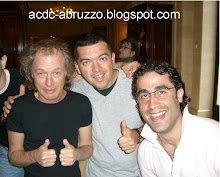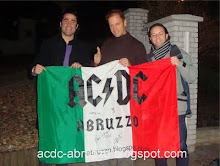Abruzzo
From Wikipedia, the free encyclopedia
| Abruzzo | |||
| Flag | Coat of arms | ||
| Location | |||
| Time zone | CET/CEST (UTC+1/+2) | ||
| Administration | |||
| Country | Italy | ||
| NUTS Region | ITF | ||
| Capital | L'Aquila | ||
| President | Gianni Chiodi (Pdl) | ||
| Basic statistics | |||
| Area | 10,794 km² (4,168 sq mi) (Ranked 13th, 3.6 %) | ||
| Population | 1,323,987 (12/2007) (Ranked 14th, 2.2 %) | ||
| - Density | 123 /km² (318 /sq mi) | ||
| Other information | |||
| GDP/ Nominal | € 26.8 billion (2006) | ||
| Website | www.regione.abruzzo.it | ||
Abruzzo is a region in Italy, its western border lies less than 50 miles due east of Rome. Abruzzo borders the region of Marche to the north, Lazio to the west and south-west, Molise to the south-east, and the Adriatic Sea to the east. Although geographically a central region,ISTAT (the Italian statistical authority) considers it part of Southern Italy, a vestige of Abruzzo's historic association with the Kingdom of the Two Sicilies.
Contents[hide] |
[edit]History
The name Abruzzo appears to derive from the Latin form Aprutium although in Roman times the region was known at various times as Picenum, Sabina et Samnium, Flaminia et Picenum and/or Campania et Samnium. This region was known as Aprutium in the Middle Ages arising from four possible sources. Many think it is apparently a corruption of Praetutium, or rather of the name of the people Praetutii, applied to their chief city, Interamnaes, now present day Teramo. Another etymology is from the Latin "aper" (boar) so that Aprutium was the "land of boars" or from "abruptum" (rugged, steep). A more recent etymology is from the Latin expression "a Bruttiis" (from the Bruttii) meaning the land that began from the Bruzi people, who moved south to occupy Calabria[1].
Until 1963 it was part of the Abruzzi region with Molise. The term Abruzzi derives from the time when the region was part of the Kingdom of the Two Sicilies and the territory was administered as Abruzzo Citeriore (Nearer Abruzzo) and Abruzzo Ulteriore I and II (Farther Abruzzo I and II ), that being nearer and farther from Naples, the capital of the kingdom. Abruzzo Citeriore is present day Chieti province. Abruzzo Ulteriore I comprised the Teramo and Pescara provinces; Abruzzo Ulteriore II is now the Province of L'Aquila.
[edit]Geography
Abruzzo covers 10,794 km² almost two-thirds of which is mountainous. The remainder of the land consists of hills sloping to a narrow plain that runs for most of the 129 kilometre long Adriatic coastline. The Apennine mountain chain runs through the Abruzzo where it reaches its greatest elevations on the Italian peninsula, the highest peaks being Corno Grande (Gran Sasso massif) (2914m) and Monte Amaro (Maiella-group) (2795m). The main rivers are the Aterno-Pescara, the Sangro and the Tronto. Abruzzo has experienced a number of major earthquakes over the centuries.
[edit]Politics
[edit]Local government
The region is divided into 4 provinces:
| Map | Name | Inhabitants | Municipalities |
|---|---|---|---|
| L'Aquila | 297,592 | 108 | |
| Teramo | 296,063 | 47 | |
| Chieti | 381,993 | 104 | |
| Pescara | 312,215 | 46 |
[edit]Economy
Since the 1950s, Abruzzo has had steady economic growth. In 1951, Abruzzo‘s per capita income orGDP was 53% of that of Northern Italy, the nation's richest region. By 1971, Abruzzo was at 65% and, by 1994, per capita income was at 76% of Northern Italy's per capita income, giving Abruzzo the highest per capita GDP of the Mezzogiorno surpassing the growth rate of every other region of Italy. The construction of superhighways from Rome to Teramo (A24) and Rome to Pescara (A25) opened Abruzzo to easy access, state and private investment in the region increased, and Abruzzo attained higher per capita education levels and greater productivity growth than the rest of the Mezzogiorno. As a result, Abruzzo's industrial sector expanded rapidly, especially in mechanical engineering, transportation equipment and telecommunications. [2] As of 2003, Abruzzo's per capita GDP was 19,506 EUR or 84% of the national average of 23,181 EUR and well outpacing that of the South (15,808 EUR).[3]
[edit]Tourism and wild life
In the past decade, tourism has increased, mostly among Italians and other Europeans. Abruzzo's wealth of castles and medieval towns, especially near the town of L'Aquila, has earned it in some quarters the nickname of "Abruzzoshire", by analogy with the "Chiantishire" nickname sometimes used to refer to the Chianti area of Tuscany, but Abruzzo is still off the beaten path for most visitors to Italy.
The region has 21 ski areas with 368 km. of runs, all within a few hours of Rome. The most developed resort being Roccaraso, followed by Campo Felice, and Campo Imperatore. Located in the highest region of the Apennines, these ski areas are at heights nearly comparable to many Alpine resorts. Because of their proximity to the Adriatic and winter precipitation patterns, they often have more snow than the Alps. Abruzzo also is popular for cross country skiing, especially on the high plain of Campo Imperatore in the Gran Sasso as well as the Piana Grande in the Majella.
The Gran Sasso massif sports the Italian peninsula’s highest peak, Corno Grande, and Europe’s southernmost glacier, Il Calderone. The Corno Grande and its neighboring Corno Piccolo provide a range of climbing opportunities from mountain hikes suitable for novices to sheer rock wall ascents suitable only for expert alpinists. Abruzzo’s lesser known peaks, especially the gentler slopes of the Majella, offer climbers the opportunity to hike and climb in solitude.
Abruzzo’s 129 km. long sandy coastline is home to a many popular beach resorts, among them Vastoon Abruzzo’s southern coast; mid-coast are Silvi Marina, whose sands are considered among the best in Italy, Giulianova, Francavilla al Mare and Pineto, and on Abruzzo’s northern coast are Alba Adriaticaand Martinsicuro.
One third of the region is designated as national or regional parkland. The following parks lie, wholly or partially, within Abruzzo:
- Parco Nazionale d'Abruzzo, Lazio e Molise (Abruzzo National Park)
- Gran Sasso e Monti della Laga National Park
- Majella National Park
- Sirente Velino Regional Park
- Lago di Barrea (Barrea Lake Wetlands)
The protected areas are environmentally important and are home to rare flora and fauna, such as the brown bear, the wolf and the chamois.
[edit]Demographics
From the early to mid-20th century Abruzzo's population was in decline. Beginning in the 1970s, this trend began to reverse as Abruzzo's population grew due to a net migration into the region. [2] In 2001, Italy's decennial census showed Abruzzo had 1,262,392 residents, a slight increase over the previous decade. With the exception of L'Aquila, whose population remained essentially unchanged, Abruzzo's other provinces had small increases in population. The provinces of L’Aquila, Teramo and Pescara, each had a 2001 population just under 300,000 while the Province of Chieti had a population just over of 380,000. [4]
Towns of Abruzzo with a population of 50,000 or more:
| Comune | Population (2007 est.) |
|---|---|
| Pescara | 122,363§ |
| L'Aquila | 72,402§ |
| Chieti | 55,102§ |
| Teramo | 54,590§ |
L'Aquila is Abruzzo's regional capital as well as the capital of the province of l’Aquila. Abruzzo’s other provincial capitals are Pescara, which is Abruzzo's largest city with a population of 150,000 as of 2000,Teramo (population 52,000) and Chieti (population 56,000). Other large municipalities in Abruzzo include Avezzano (population 40,000), an industrial and high technology center, and Lanciano (population 36,000) another important industrial and tourism center.
[edit]Culture
In the past, the region of Abruzzo was well known for the transumanza, the migratory movement of sheep principally south to the region of Puglia during the cold winter months.
The regional accents of Abruzzo include Teramano, Abruzzese Orientale Adriatico and Abruzzese Occidentale. The first two form part of the Italiano meridionale-interno dialect of southern Italy also known simply as "Neapolitan" due to the region having been part of the Kingdom of Naples and the Two Sicilies, while the Italian of L'Aquila Province is related to the Osco-Umbro dialect of central Italy, including the one of Rome. It should be noted that Abruzzo's Italian dialects are not particularly marked. In fact, Harvard University bases an intensive summer language program in Vasto, a resort town on Abruzzo's southern coast. There is, however, a small Albanian linguistic area at Penne, in the Province of Pescara.
Among Abruzzo many historic towns are: Sulmona at the foot of the Maiella massif and known for Italy’s most famous ancient poet , Ovid, Scanno, a lakeside hill town, Atri a picturesque artistic center, and the hillside towns of Penne, Lanciano and Loreto Aprutino.
[edit]Medieval and Renaissance hill towns
Abruzzo holds some of Italy's best-preserved medieval and Renaissance hill towns. The abrupt decline of Abruzzo’s agricultural economy in the early to mid-20th century saved some of the region’s most beautiful hill towns from the onslaught of modern development. Many lie entirely within regional and national parks so their preservation is all but guaranteed. Among the most well preserved are Castel del Monte (AQ) and Santo Stefano di Sessanio, which lie in the Gran Sasso National Park on the edge of the high plain of Campo Imperatore and nestled beneath the Apennines’ highest peaks; both hill towns, which were ruled by the Medicis for over a century-and-a-half, have relatively little tourism. Between the two towns sits Rocca di Calascio, the ruin of an ancient fortress popular with film makers. Also within the Gran Sasso National Park is Castelli, an ancient pottery center whose artisans produced ceramics for most of the royal houses of Europe. Although still home to many artisans, Castelli has a modest tourist trade.
Other medieval hill towns located fully within Abruzzo's park system are Pacentro in the Parco Nazionale della Majella and Pescasseroli in the Parco Nazionale d'Abruzzo. Pacentro, which features a 14th century castle with two intact towers, has been little touched by modernization and is also known for being the origin village of the grandfathers of the entertainers Madonna and Dean Martin.






































